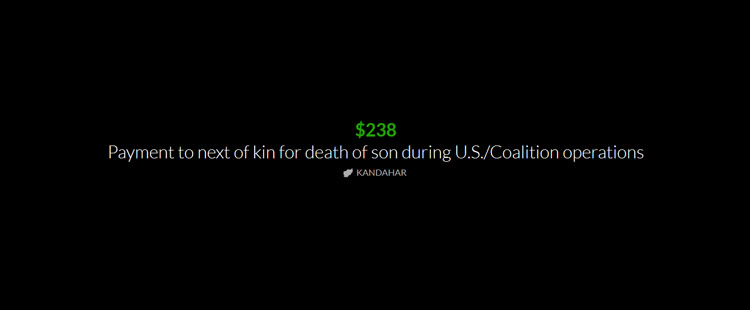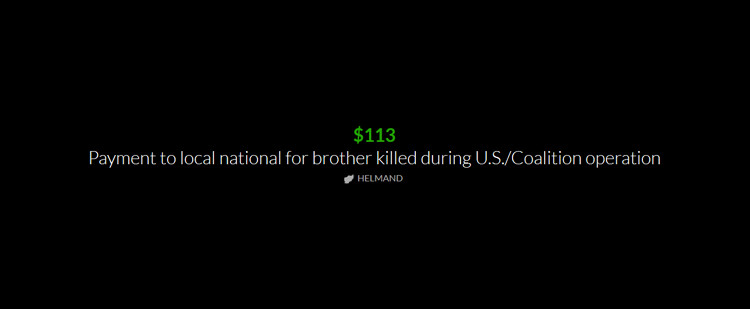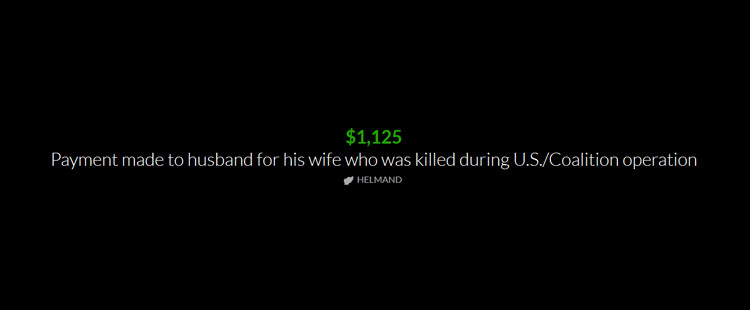The Intercept, February 27, 2015
Our Condolences
How the U.S. Paid for Death and Damage in Afghanistan
By Cora Currier
An armored vehicle ran over a six-year-old boy’s legs: $11,000. A jingle truck was “blown up by mistake”: $15,000. A controlled detonation broke eight windows in a mosque: $106. A boy drowned in an anti-tank ditch: $1,916. A 10-ton truck ran over a cucumber crop: $180. A helicopter “shot bullets hitting and killing seven cows”: $2,253. Destruction of 200 grape vines, 30 mulberry trees and one well: $1,317. A wheelbarrow full of broken mirrors: $4,057.
A child who died in a combat operation: $2,414.
These are among the payments that the United States has made to ordinary Afghans over the course of American military operations in the country, according to databases covering thousands of such transactions obtained by The Intercept under the Freedom of Information Act. Many of the payments are for mundane incidents such as traffic accidents or property damage, while others, in flat bureaucratic language, tell of “death of his wife and 2 minor daughters,” “injuries to son’s head, arms, and legs,” “death of husband,” father, uncle, niece.
The databases are incomplete, reflecting fragmented record keeping in Afghanistan, particularly on the issue of harm to civilians. The payments The Intercept has analyzed and presented in the graphic accompanying this story are not a complete accounting, but they do offer a small window into the thousands of fractured lives and personal tragedies that take place during more than a decade of war.
The Price of Life
The data that The Intercept obtained comes from two different systems that the U.S. military uses to make amends.
The Foreign Claims Act, passed in 1942, gives foreign citizens the ability to request payment for damages caused by U.S. military personnel. But the law only covers incidents that happen outside of combat situations — meaning that civilians caught up in battles have no recourse.
Since the Korean War, however, the U.S. military has realized that it’s often in its best interest to make symbolic payments for civilian harm, even when it occurs in combat. Over the years, the Pentagon authorized “condolence payments” where the military decided it was culturally appropriate.

Theintercept.co/condolences
Such condolence payments were approved in Iraq a few months into the 2003 U.S.-led invasion, and in Afghanistan beginning in 2005. They soon became part of the “hearts and minds” approach to counterinsurgency. To put it another way, in the words of an Army handbook, this was “money as a weapons system.”
While it might seem cynical to offer token compensation for a human life, humanitarian organizations embraced the policy as a way to acknowledge deaths and the hard economic realities of war zones.
Condolence payments are meant to be symbolic gestures, and today in Afghanistan, they are generally capped at $5,000, though greater amounts can be approved.
Payments under the Foreign Claims Act take into account any negligence on the part of the claimant, as well as local law. Douglas Dribben, an attorney with the Army Claims Service in Fort Meade, Maryland, said that officers in the field do research, sometimes consulting with USAID or the State Department, to determine the cost of replacing damaged property — “What’s a chicken worth in my area versus what it’s worth in downtown Kabul?”
Claims for injuries incorporate the cost of medical care, and in the case of wrongful death, the deceased’s earning potential and circumstances. “If I have a case of a 28-year old doctor, they are going to be paid more than we’d pay for a child of four,” Dribben said. “In Afghanistan, unfortunately, a young female child would likely be much less than a young boy.”
The system is imperfect, however. Residents of remote areas often can’t access the places where the U.S. military hands out cash. The amounts given out, or whether they are paid at all, often depend on the initiative of individual soldiers — usually the judge advocates who handle claims, or commanders who can authorize condolence payments.
In 2007, the American Civil Liberties Union obtained documents detailing about 500 claims made under the Foreign Claims Act, mainly in Iraq. These were the original, often hand-written records of incidents, their investigations, and the military’s ultimate decision to pay or deny the claim. Jonathan Tracy, a former judge advocate who handled thousands of claims in Iraq and then devoted years to studying the system, analyzed the entire dataset and found that the decisions often relied on over-broad or arbitrary definitions of combat situations, and that people who were denied claims were only sometimes awarded condolence payment. Yale law professor John Fabian Witt also noted that “relatively minor property awards for damages to automobiles and other personal property often rivaled the death payments in dollar value.”

Theintercept.co/condolences
“They present it as if it’s very black and white, as though there’s the circle of things we can pay for, and you decide if the incident is in or out of that circle, but that’s not the way it happens,” Tracy told The Intercept. “You’d have two different attorneys doing two different things and [civilians] who’d had much the same thing happen to them would get very different compensation.”
Last year the annual defense appropriations bill included a provision, championed by Senator Patrick Leahy, D-Vt., which instructs the Pentagon to set up a permanent process for administering condolence payments. The measure is intended to prevent the delay and inconsistencies that marred the system in the early years in Iraq and Afghanistan, and to improve record keeping, so that the Pentagon doesn’t start from scratch in each new conflict.
A defense official told The Intercept in an emailed statement that the Pentagon has not yet implemented the provision, but is “reviewing the processes related to ex-gratia payments to determine if there are areas where improvements can be made.”
Marla Keenan, managing director of the Center for Civilians in Conflict, believes that “as the conflict in Iraq and Syria has escalated, they are starting to see a reason for this type of policy to exist. It’s unfortunate how a new context where this could be used is the impetus.”
Finding the Data
The United States and its allies do not tally civilian deaths in Afghanistan. The United Nations only began keeping track of civilian casualties in 2009; using a conservative count that requires three sources for each incident, the U.N. now reports that more than 17,700 innocent Afghans have died in the past five years of fighting, the majority of them killed by the Taliban or other groups fighting the Afghan government and coalition forces.

Sample Afghan claim form
Looking at compensation paid out under the Foreign Claims Act or in condolence payments is one way to get a window into the damage caused by the U.S. presence. Yet it’s difficult to draw conclusions from the military’s records, which are muddled and incomplete, by their own admission.
Every cache of documents released comes with caveats. For example, The Nation obtained thousands of pages’ worth of records for payments for condolences and other “battle damage” in 2013. Asked for total figures, a military spokesman told the magazine, “I could wade through the numbers to the best of my ability but my numbers would be a guess and most likely inaccurate.”
The Intercept received several years’ worth of recent data on condolence payments from the military through a Freedom of Information Act request. These records come from a military database keeping track of the Commander’s Emergency Response Program, a special pot of spending money for “goodwill” projects.
The database entries are sparse, giving only the basics of who was killed or injured, with no detail on when or how the incident occurred. Location is given only at the province level. Nonetheless, the data represent the Pentagon’s clearest accounting of how much money it spends on condolence payments. (This data does not include “solatia,” which, just like condolence payments, are compensation for death and injury. But they are paid out of a unit’s operating funds, and the Pentagon has said previously it does not have overall figures for solatia.)
According to the data we received, in fiscal years 2011 through 2013, the military made 953 condolence payments totaling $2.7 million. $1.8 million of those were for deaths, and the average payment for a death was $3,426. Payments for injuries averaged $1,557.
Some payments are for multiple people harmed in one incident. For instance, the largest single payment, from 2012, offers $70,000 for “death of a mother and six children.” The largest payment for a single death occurred in 2011, when the father of “a local national” who was killed was given more than $15,000. Some family members received as little as $100 for the death of a relative.
Asked about records for payments made before 2011, the Pentagon directed questions to the press office for coalition forces in Afghanistan, which did not reply to repeated inquiries from The Intercept.
Also through the Freedom of Information Act, The Intercept received Foreign Claims Act data from the Army, which handles Afghanistan for the entire U.S. military. As with the condolence payments, the database doesn’t include the documentation behind each claim. Rather, it shows a quick synopsis, date and amount for each claim filed.
In all, the Army released 5,766 claims marked for Afghanistan, filed between Feb. 2003 and Aug. 2011, of which 1,671 were paid, for a total of about $3.1 million. Of those claims, 753 were denied completely, and the rest are in various kinds of accounting limbo.
This is only a portion of the claims that were actually made and paid. Douglas Dribben, the attorney with the Army office, described the database as “G.I.G.O. — Garbage In, Garbage Out.”
Judge advocates in the field are supposed to regularly update the database with claims received and paid, but spotty Internet access and erratic schedules often made that impossible. Tracy, the former Army attorney, said that in Iraq, he had to enter all the claims he received weekly. In practice, “that never really happened,” he said.
A 2010 guidance for claims officers takes a pleading tone: “We know [claims] payments are not your only mission and the last thing you really want is another report but in all honesty the last thing any of us want is an unauthorized expenditure of funds.”
A more reliable estimate, Dribben said, comes from Army budget data, which reflects the amount of money transferred out to the field to pay claims. The Army Claims Service did not provide that information, but a training guide from 2009 states that for that fiscal year, the Army had paid $1.35 million in 516 claims in Afghanistan, with 202 denied.
The total for Iraq that year was over $18 million; overall, Afghanistan saw fewer and smaller claims than Iraq, because of remote geography and fewer U.S. troops deployed. Prices for replacement goods or lost wages were generally lower, Dribben said.
The claims synopses typically contain missing words, garbled grammar or obvious errors in the various entry fields. Most refer to a “claimant.” Some are entered in the first person. A few dozen have no synopsis at all. Many are completely enigmatic: what happened when “claimant feared soldiers would open fire and panicked?” The claimant was paid more than $3,200.
“Each one took maybe 30 seconds to enter,” Tracy said. “There wasn’t really room or time to put in a narrative.”
The database categorized just 18 payments as wrongful deaths between 2003 and 2011 — very likely an undercounting, Dribben said. The average of those payments was about $11,000; the highest was $50,000, paid to someone in eastern Afghanistan, because “coalition forces killed his father.”
The Intercept’s Margot Williams and Josh Begley contributed research to this report. Eric Sagara, formerly of ProPublica, also contributed.

Theintercept.co/condolences

Theintercept.co/condolences

Theintercept.co/condolences

Theintercept.co/condolences
Characters Count: 15453
